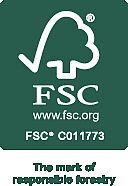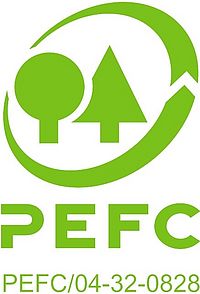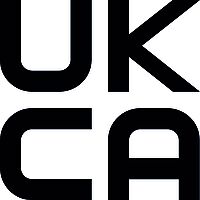Areas of application
Preventive fire protection in interior design, for damp and wet areas and wherever outstanding durability of the material is demanded, e.g. as wall protection. Also for furniture and installation elements, particularly when low material cross-sections or open edge solutions are required as part of fire protection concepts.
Certificates & labels

CE conformity
The CE-marking documents that goods comply with the safety and health requirements of the European Union. Its aim is to guarantee safe, flawless and high-quality goods on all European markets.

FSC-certified
The Forest Stewardship Council (FSC) is a global, not-for-profit organization dedicated to the promotion of responsible forest management worlwide. FSC defines standards based on agreed principles for responsible forest stewardship that are supported by environmental, social and economic stakeholders.

PEFC certified
PEFC is the largest institution for ensuring sustainable forest management through an independent certification system. Wood and wood products with the PEFC seal originate demonstrably from ecologically, economically and socially sustainable forestry.

UKCA conformity
The UKCA-marking documents that goods comply with the safety and health requirements of the United Kingdom. Its aim is to guarantee safe, flawless and high-quality goods on all United Kingdom markets.
Product section

Availability
Formats
| Length (mm) | Width (mm) | Thickness (mm) |
|---|---|---|
| 2,800 | 2,070 | 4 | 5 | 6 | 8 | 10 | 12 | 13 | 15 |
| 5,600 | 2,070 | 4 | 5 | 6 | 8 | 10 | 12 | 13 |
Product features
Product standard
- EN 438-4
Core material
- Flame retardant compact laminate black: Uniform black through-pigmented solid compact laminate core, suitable for applications with high requirements for the surface spread of flame.
Density
- Min. 1,350 kg/m³
Reaction to fire
- Flame retardant
- 2,800 x 2,070 x 4 - 6 mm: C-s2,d0 (EN 13501-1)
- 2,800 x 2,070 x 8 - 15 mm: B-s1,d0 (EN 13501-1)
- 5,600 x 2,070 x 4 - 6 mm: C-s2,d0 (EN 13501-1)
- 5,600 x 2,070 x 8 - 13 mm: B-s1,d0 (EN 13501-1)
EC scope
- EN 438-7:2005
- Compact laminate intended for internal wall and ceiling finishes (including suspended ceilings)
Formaldehyde emission class
- E1 E05
Antimicrobial effect
- Surface with antimicrobial effect in 24 h for interior fit-out and finishes – Test Methodology JIS Z 2801 / ISO 22196
Product safety
- This product follows the REACH regulation EC 1907/2006 an article. Following Article 7 it does not need to be registered.
- The surface is physiologically safe, and approved for direct contact with food acc. to Regulation (EU) No. 10/2011.
- The decorative surface and the core consists of paper layers, which are impregnated with thermosetting resins. The resins harden completely during the manufacturing process by heat and high-pressure. They form a stable, resistant and non-reactive material.
Special
- Depending on the decor and surface texture, slightly different surface visual impressions can result between cut panels viewed from different angles. This is a result of the production methods and does not constitute a quality defect.
- Especially for large applications, we recommend paying attention to the colour and texture uniformity of the boards and cut products used when further processing and installing and that the production direction is taken into account.
- The smoother the structure and the the darker the decor, the more sensitive it is to stains.
- With intensive plain decors, especially in the red range, colour pigment wash-out may occur under certain circumstances. It is possible that colour pigments are not bound by the resin during the impregnation of the decor paper and are only deposited on the surface of the impregnate and are thus directly on the surface. If cleaning is then carried out, slight discolouration of the cleaning cloths can be observed.This is particularly the case when solvent-based cleaners are used. This is not a product defect.
- Due to the black core of the material, minor decorative deviations to other products cannot be avoided.
- For production-related reasons, there may be minor colour variations in the black material core.
- Decor-structure-combination front side = Decor-structure-combination reverse side
- Subsequent oiling (with suitable cooking oil) of the machined edge can reduce machining and wear marks.
- Please note that in everyday use, polishing, scratches and shiny spots may occur due to mechanical stress, which are particularly visible on darker decors. This does not represent a quality defect or a restriction of usability. Rather, it reflects the natural ageing of the surface. The product complies with all requirements of EN 438.
- FSC certification or PEFC certification available on request.
Colour and surface match
- Decor, structure and core board all influence the final appearance of the end product.
- Due to the product-specific differences in production technologies, even identical decor/structure/core board combinations can result in slight optical and tactile deviations across different product groups and formats. Such deviations do not constitute a defect.
- The choice of surface structure in particular has a significant influence on the visual impression, the tactile perception as well as the technical characteristics of the product. Thus, the overall impression of a decor can change almost completely depending on the surface structure. Furthermore, mechanical influences on the product surface can lead to a higher contrast optical perception with dark decors.
- To ensure that you always achieve the best results with our products and to clarify any deviations in advance, we will be happy to advise you individually.
Product handling
Processing
- Especially for large applications, we recommend paying attention to the colour and texture uniformity of the boards and cut products used when further processing and installing and that the production direction is taken into account.
Machines and tools
- Can be worked with carbide tipped tools on conventional woodworking machines.
Fitting technology
- All conventional removable and non-removable fittings for solid wood and wood materials are suitable.
Installation and assembly
- Sufficient conditioning is required prior to installation. The premises themselves need to be air-conditioned according to the future use.
- Please ensure that the material is processed and fitted correctly and using the best available technology.
- Ensure good rear ventilation and climate equilibrium on both sides in the installed condition. For adequate air circulation the void should be at least 20 mm. It is important to interrupt horizontal substructures as well as the top and bottom ends of the wall panelling so that vertical rear ventilation is possible. Avoid direct fixing on the surface without air gap.
- Ensure adequate room for movement of the panel material in the installed condition. Panel joints are to be made with oversize joints and throughholes.
- Make sure that expansion of installed elements is not prevented. Please observe that when panels are combined with other materials their coefficients of expansion may differ.
- Newly built walls (made of brick or concrete or plastered walls) contain considerable amounts of moisture. Before covering them with panels they must be completely dried out.
- Protect the substructure against corrosion.
- The base may not be moist or unstable. Please make sure that minimum carrying capacity and stability correspond to the usage.
- Avoid direct exposure to heat and any possible dehydration of the surfaces by light- or heat radiation or by air currents from heating- or air conditioning systems.
- For further information on processing and installation of HPL and compact HPL, please respect the recommendations of ICDLI (www.icdli.com).
Storage, handling and transport
- Panels must be fully and horizontally stored with edges flush on a flat and clean base covered with plastic foil. Cover the top panel fully with foil and a cover board.
- Protect from moisture and wet conditions.
- Avoid direct exposure to heat and any possible dehydration of the surfaces by light- or heat radiation or by air currents from heating- or air conditioning systems.
- Foreign bodies or impurities in the pallet of sheets can lead to impressions and damage to the surface of the board.
- Sheets / boards must not be moved against each other, they should be moved individually by hand or with suction equipment.
- Ensure that sufficiently large and sturdy bases, e.g. pallets, are used for the transportation of stacked sheets. The sheets on the pallet must be secured against slipping.
Cleaning and care
- The surface can be cleaned with water and gentle cleaning agents. To remove stubborn stains, please observe the recommendations in the data sheet "Cleaning of HPL surfaces" (www.icdli.com).
Technical downloads
Brochures
You like to learn more?
Please get in touch with us! We look forward to hearing from you.






